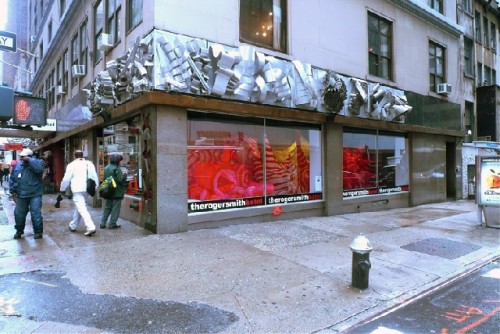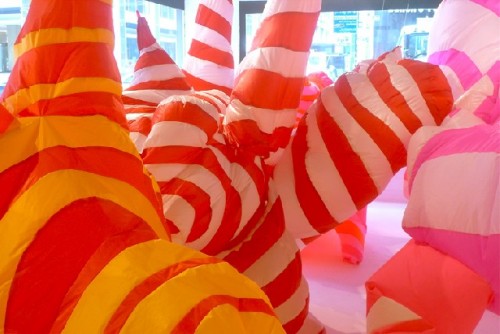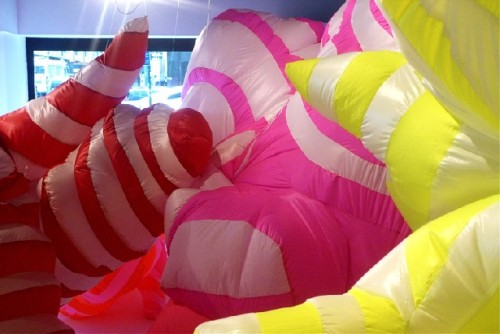The Lab Shows Anne Ferrer Billowing Beauty
Music by Carol Worthey
By: Mary Hrbacek - May 23, 2011
Anne Ferrer’s new series of colorful cloth sculptures, curated by Edward Rubin, is reminiscent of inflatable, shaped balloons that wink and bob in a kind of rhythmic modern dance. Up-down movements mingle with the in-out “breathing” of the air that inflates and deflates each work.
The seven pieces are composed as a group, but each work is affixed with an electronic programmer that keeps its individual rhythmic movement activated. The pieces are anchored in a glass-fronted space that faces Lexington Avenue and 47th Street. They impact their surroundings, breaking the boundary between the gallery and the curious public who stop to wonder at the eye-catching array of indescribable shapes and forms. The works are ideal for attracting the attention of a busy crowd in motion.
The installation is tightly composed to snugly fit the thirty-foot gallery, occupying the space from top to bottom. The works seem to juggle and sway as if in an effort to gain their own territory, as plants and sea animals do in the wild survival struggle inherent in nature.
Beauty is rarely tame, but these works are playful rather than threatening. Their optimistic attitude and indefinable meanings stir the imagination. They hint at circus tents, inflatable water toys, unusual animals, undersea life, gardens, French striped candy, or yummy pastries. By keeping forms fluid and definitions blurred, Ferrer encourages observers to supply their own personal interpretation. This quality of openness allows viewers to “play” in the garden as collaborators with the artist.
Ferrer is decidedly Catalan and French. At an early age, without television or much else to occupy her at home, she learned to sew, a skill that has become an intrinsic part of her life and her art. She uses a sewing machine as her brush. First she constructs patterns by cutting fabric in circular shapes, which she then pieces into larger structures that ultimately comprise the final sculptures. The stitches and seams define her forms in an organic manner; she sometimes abandons the pattern to create unexpected configurations. The artist also designs her own fashions in which the shapes from her works migrate to her personal attire.
Warm colors, especially red and orange, exude a dominant aura. They often signal danger or desire, but here the colors are enveloping and welcoming. The sensuality and lushness of the satin and silk surfaces are especially alluring. They caress the eyes, hinting at satin quilts or bed-covers, whereas the rip-stop or raincoat fabric provides a more sporty or utilitarian subtext.
The pieces in which white stripes alleviate the red resemble quasi-banners or flags. These items are often associated with personal, family or national identity, disclosing clues to the deeper meaning of the works. The stripes interact to make unusual patterns that stream and flicker through the seven works, uniting the entire compilation. Solid colors are interpenetrated with harmonious variations in hue, just as forms in paintings are often softened and varied. Painting plays a large role in this work; color is not often associated with sculpture as a genre. They are the antithesis of traditional sculpture; they are light and airy, not heavy or massive, and the entire show can be transported in one suitcase. This is an exceptionally “green” or environmentally friendly approach to art making.
In her semi-intuitive process, Ferrer makes patterns, but also deviates from them to construct improvised shapes that evoke unexpected emotions. The works assume a life of their own; their size alone removes them from the orbit of easy apprehension, or clear definitions. Viewers must grapple with mystery and uncertainty as they ask themselves what exactly they are seeing.
Like a parade, the installation is lively, active and lush. The tone is determinedly optimistic. These soft sculptures succeed in engaging the senses and the imagination. They are not meant to be pondered but to be enjoyed, and would be huggable if they were not airy and light. The meaning of the installation is found in its interrelationships, not in individual works. Animals, gardens, candies, tents, kites, inflatable water toys, flags and balloons all have a portion of the multi-meaningful ménage. The organic shapes, warm harmonious hues, and rhythmic organization interact, infused with vivid joyous fun. Los Angeles composer Carol Worthey’s delicate sensitive music accompanies the display; it can be heard as one views the installation from the street.
The LAB (for installation + performance art)
501 Lexington Avenue
New York, NY 10017
Ph: 212-339-2092
Fax: 212-758-4061
ddruttman@rogersmith.com
www.thelabgallery.com
www.rogersmithlife.com
www.facebook.com/thelabgallery
www.twitter.com/TheLABGallery




